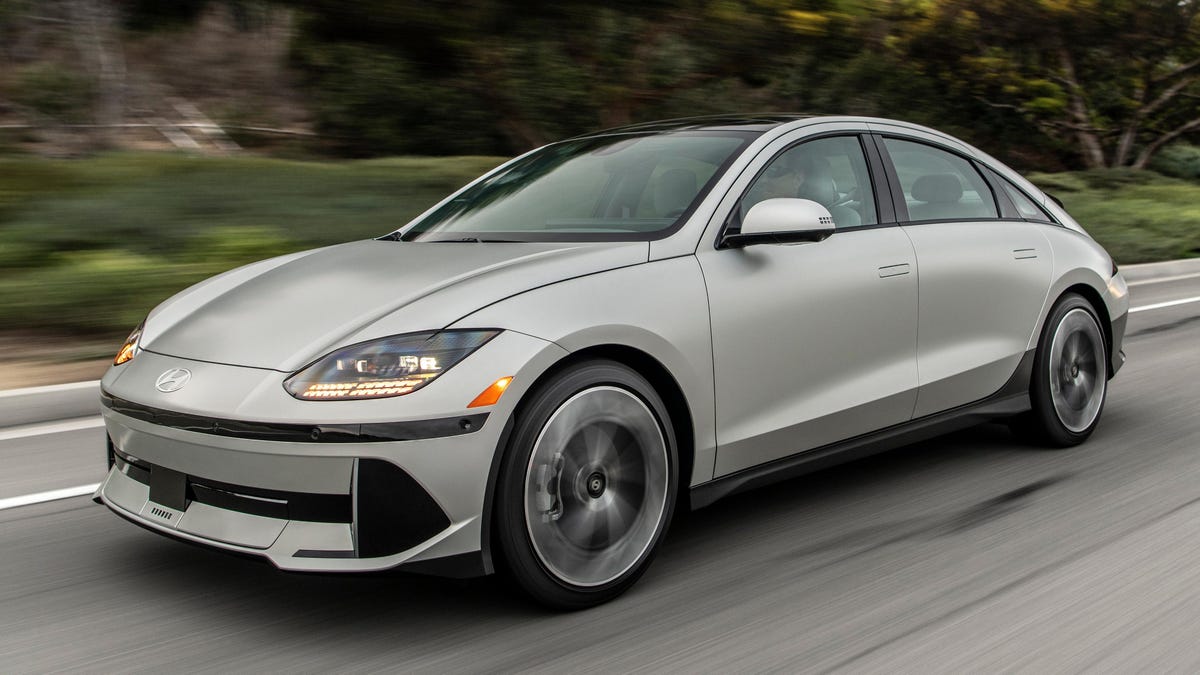From layoffs at Tesla, Rivian and others to big price cuts on the Ford F-150 Lightning and Mustang Mach-E, Hertz selling off its fleet of electric vehicles, Tesla’s deliveries being down and even Volkswagen delaying the ID7’s U.S. launch, it could be easy to get the impression that the EV industry is dying. As Bloomberg argues, though, it’s much more likely that we’re instead looking at “an adolescent industry on the verge of its next growth spurt.” Especially if you remove Tesla from the picture.
For example, take a look at how sales from the first quarter of 2024 compare to the same time last year. Yes, Tesla and GM took a step back, but Hyundai’s EV sales were up 56 percent. Most companies would kill for growth like that in any segment, and yet, compared to many of the other biggest names in the EV space, that’s not even all that impressive. Rivian was up 59 percent, Mercedes was up 67 percent, and Ford grew 86 percent. Toyota’s EV sales were also up 86 percent.
Part of the problem for Tesla, which was down 13 percent in Q1, and General Motors, down an even more drastic 21 percent, is a lack of new products. The Cybertruck has generated a lot of attention, but it’s not a mainstream product that many people can afford, and both the Model 3 and Model Y are pretty old at this point, even if the Model 3 did recently receive a refresh. GM, on the other hand, killed off the relatively affordable Bolt before its replacement was ready to go, and the launch of the Blazer EV was nothing short of a disaster.
We’re not entirely sure how to help Tesla since the board hasn’t shown any interest in kicking CEO Elon Musk to the curb, but when it comes to GM, it seems like the issues it’s currently dealing with are more of a hiccup than a sign the company can’t successfully sell EVs. Over the next year, it plans to significantly increase the number of EVs it offers and is still betting big on EVs even as some other brands pull back.
“We’re still seeing growth in demand, just not at the same pace for every brand,” Cox Automotive’s head of industry insights Stephanie Valdez-Streaty told Bloomberg. “Right now Tesla doesn’t have new models, Ford doesn’t have a lot in the pipeline. But Hyundai, BMW, Kia, Cadillac — they’re really moving the needle forward.”
If GM CEO Mary Barra is to be believed, the problems that have plagued the automaker’s latest EV platform, which it calls Ultium, have been solved, and it expects to build between 200,000 and 300,000 EVs in 2024. Speaking recently on the U.S. EV industry, Barra told reporters, “I think it was overhyped and now it’s probably underhyped. The truth is somewhere in the middle.” The International Energy Agency is also optimistic, suggesting that EV sales in 2025 will more than double compared to 2023, rising from 1.1 million to 2.5 million next year.
Still, Tesla is currently the only automaker building EVs at any sort of scale. In Q1, the best-selling non-Teslas were the Ford Mustang Mach-E, Rivian R1s and Ford F-150 Lightning, which saw sales of about 9600, 8000, and 7700 units respectively. Meanwhile, in the same time period, Tesla sold just under 97,000 Model Ys. With one company having such a massive share of the current EV market, it’s almost guaranteed that other automakers’ successes will cut into Tesla’s sales.
It’s also hard to separate Tesla’s recent struggles from the problems its CEO is dealing with at other companies, in public and bringing on himself. So while other executives may see Tesla’s problems as a sign that they should take a step back on EVs, one Bloomberg EV analyst Corey Cantor says that would be a mistake, saying, “Automakers are probably freaking out too much, as usual, but there is a bit of a Tesla issue. If they want to start taking market share, or even just perform at a high level, they need to start producing EVs at mass volume.”
That said, Bloomberg still believes the EV market will grow another 20 percent this year, which as it points out is a lot less than the 46 percent growth we saw last year. And yet, if that “low” growth continues going forward, in about a decade, essentially all new car sales would be EVs. Whether that will happen still remains to be seen, but like we said before, we’re definitely not in a scenario that’s all doom and gloom. In fact, there are actually plenty of reasons to be optimistic about EV growth in the U.S. over the next several years.

